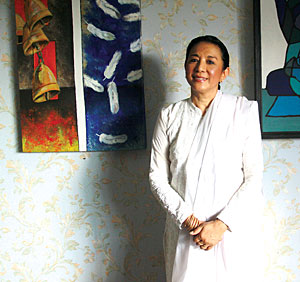 |
Sarah Giri (right) of the Nepal-Indo Deaf Art and Culture Society (NIDACS), identifies herself as 'culturally Deaf'. For the last nine years, she has worked to bring awareness to the deaf community in South Asia, and NIDACS will run Eyes Empowered Part II, a weeklong exhibition of Deaf Art by Nepali and Indian deaf artists commencing with a soirée prevue on 3 June sponsored by the Summit Hotel.
NIDACS provides a platform for the deaf community, working not as a charity for a disability group but as a repository for a culture complete with its own history, values, and most importantly language.
 PICS: MARCUS BENIGNO |
"Language and literacy are prerequisites of a culture," Giri says as she demonstrates her fluency in sign language. "With deaf language came Deaf (capital 'D') culture and heritage. The hearing word is written on board surfaces, while the deaf write in space. Throughout history groups, whose rights and privileges have been denied, have come together to voice their experiences through art."
Under the genre of 'disenfranchised art,' there are two categories: affirmation art and resistance art. Giri explains, "The first is about validation and celebration where, 'I'm deaf, and so what? This is a wonderful world, and this is our culture.' And the second talks about the oppression and segregation from the dominant hearing culture and its portrayal in their suppression."
Deaf subalternity entails a paradox of isolation and dependency, where for the deaf, even the closest kith and kin are far and estranged. "The Lonely Walk" (right) by Deaf artist Anirban Das Gupta paints a bright picture of a woman walking alone, representing the detachment and poignant optimism of deaf individuals in a predominantly hearing world.
Work opportunity for deaf Nepalis is scarce and limited. Since 1997, Shyam Kakshapati's Bakery Café has employed dozens of deaf people in Kathmandu. But Nepal shouldn't stop there.
 |
On top of its art workshops and cultural events, NIDACS challenges corporations to invest in the potential of deaf individuals as web developers and designers, architects, and accountants.
In a second work, Das Gupta portrays the deaf perspective as an invisible minority. Giri captions the piece: "The whole world sleeps in silence, undisturbed. While under a lit corner, a group of deaf is signing. All they need to communicate is a little moonlight."
Eyes Empowered Part II, NIDACS 2nd Annual Deaf Art Exhibition, Summit Hotel, 3 - 10 June


